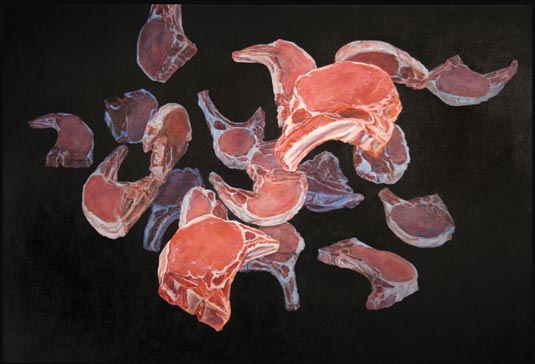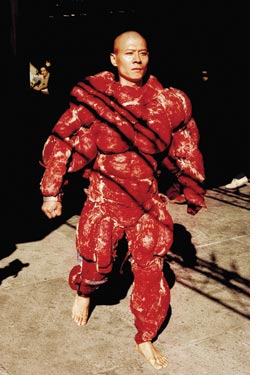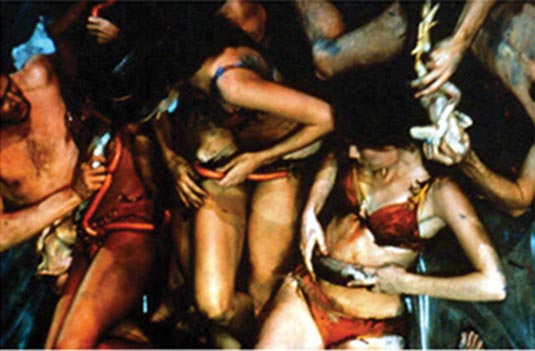| |
Meatpaper FIVE
Carne Diem
What meat art can tell us about life and death
by Richard Fulmer
SEPTEMBER, 2008

David Raymond, Twenty-one Chops,
2003, acrylic on canvas, 42" x
60"
BACK
IN 1964 I
was a reluctant college student distracted by a new-found
interest in modern dance. I didn’t have
much technique, but I was an enthusiastic improviser looking
for an art form I could fit into. I was lucky to be young
at a time when dance and action painting were coming together
in what would eventually be called “performance art,” a
style in which my limitations were tolerated. A painter,
Carolee Schneemann, had just presented a pioneering piece
of that sort in New York called Meat Joy. I missed the
performance, but the permissive connotation of “meat” and “joy” in
the title and the photographs I saw of unclothed, paint-smeared
men and women rolling around on the floor with raw chickens
suggested a bright future for me in that genre.
Ultimately,
I turned out to be a better clinical psychologist than
dancer, but was never sorry for the years I spent studying
movement. So when, in June, I saw a notice in the Boston
Globe for a show called “Meat After Meat
Joy” at the Pierre Menard Gallery in Cambridge, I
was eager not to miss it. This time, I brought my son Andrew,
who is 19 years old, the same age I was when I first encountered
Carolee Schneemann’s work.
When visiting a gallery show
composed largely of uncooked meat, one key consideration quickly
becomes clear: the need for refrigeration. Still, it took Andrew
and me a few minutes to make sense of the thick, frosty pillars
that occupied the first room of the gallery. We had better
luck with Betty Hirst’s Baby (2008) a thick, flat,
gingerbread girl of a female infant, featureless except
for her clearly-modeled vagina — and entirely sculpted
from raw beef. Having learned to expect meat as a medium,
we circled back to the pillar, which, on closer inspection,
we could now see was a head, also by Hirst (Bust, 2008).
There was something disturbing about these human shapes
rendered in skinless meat — a layer of flesh we’d
expect to see only in serious injury was here completely
exposed.
This is meat as we would never see it in
the real world, elegant, pristine, even sublime, like the space
station in the film “2001:
A Space Odyssey.”
The gallery’s second room introduced
us to meat as subject, in this case of painters like David
Raymond (Twenty-One
Chops, 2003), whose thick cuts of meat float weightlessly
in space. This is meat as we would never see it in the
real world, elegant, pristine, even sublime, like the space
station in the film “2001: A Space Odyssey.”
But
meat can also be raunchy, as Boston-based painter Anthony Fisher
demonstrates in thick impasto. Fisher brings us so close to
his subject, we almost wrestle with the big heavy chunks that
fill, and sometimes exceed, the frame. Fisher also confronts
us with the animal that once was. In Mea Culpa, Agnus Dei,
and Feast (2007) we meet a living lamb, at times skinless
or with only patches of its wooly coat remaining, posed upright
and, in Mea Culpa, staring straight at the viewer.
You don’t
need Fisher’s
titles to sense his interest in the guilt and sacrifice
inherent in meat eating, his insistence that we recognize
how consuming meat requires the loss of another being.
Heide
Hatry, the show’s curator, agrees that this
theme of an animal’s loss of life is key to the show.
But “Meat After Meat Joy” also refers
to a different sort of loss: the loss of recognition that Schneemann
herself experienced when critics of both sexes objected
to the carnality of her work, what one writer described
as “partial and full nudity, sensual pleasure, sexual
equality, and, in her 1968 film “Fuses,” explicit
lovemaking” (Bruce McPherson, preface to More Than
Meat Joy). In Hatry’s view, “Fuses” was
released “too early,” and dismissed by an audience
not yet able to make sense of it as art. In 2007, Hatry
curated a solo show for Schneemann; this year’s “Meat
After Meat Joy” is a continuation of her effort to
revive interest Schneemann’s work.
But Hatry’s
interest in meat art goes beyond Carolee Schneemann. In her
own sculptural work, Hatry stitches together pieces of animal
skin and parts to craft portraits of women. Hatry grew up on
a farm, where her chores included cutting pig carcasses. In
pig farming she says, “everything
of the animal is used, but their skin is thrown away. I
try to make a use out of it.” To Hatry, making art
from pig skin is a way of recovering the lost life of the
animal. Defying, acknowledging, or respecting death and
the passage of time may be a motive for any art, but the
use of as ephemeral a medium as flesh emphasizes that theme.
 |
| Zhang Huan, My New York, 2002, still
from video performance |
| |
Andrew and I saw some of those same
themes played out in the fabric sculpture of Argentian artist
Tamara Kostianovsky, whose life-size sides of beef made from
her old clothes (Abacus, 2008), hang, three in a row, from
meat hooks, as in a warehouse. The several iterations of
the same form emphasize the impersonality of the carcasses,
just as the use of salvaged clothing humanizes them, connecting
us to the animals we consume.
“Meat After Meat Joy” is anchored by two short
films of performance art that are shown continuously in
one of the galleries. In My New York, Zhang Huan, a Chinese
artist who now resides in New York City, walks through
city streets wearing a red meat suit of his own creation.
Zhang’s meat suit is modeled in the shape of an extremely
muscular body builder, moving as flexibly as if it were
Zhang’s own flesh. The suit gives the impression
of muscles bare of skin — a living, flayed body — but
Zhang’s uncovered hands, feet and head signal that
all is well. As he walks through city streets on a brilliant,
sunny day, Zhang’s assistants hand him a series of
white doves, which he holds briefly and then releases.
Zhang, in turn, gives doves to passers-by in a careful
and deliberate exchange: Facing the stranger, Zhang holds
the dove lightly in both hands, making sure the recipient
has found the same light, two-handed grip before relinquishing
it. My New York suggests a tension between order and
destruction — a
powerfully muscled man handling doves with great gentleness,
and then initiating strangers into that same gentle manner.
Meat, in Zhang’s New York, has the power to confront
us with our own true nature, while opening up new models
of social exchange.
My New York suggests a tension between order and destruction.
The second video belongs, of course,
to Carolee Schneemann. Like My New York, Schneeman’s
mucholder Meat Joy (1964) uses meat to evoke a combination
of fascination and alarm. In Meat Joy, men and women, scarcely
dressed, writhe on the floor in a continuously moving embrace.
No performer is seen individually, and it’s hard to
tell how many there are, or whose body parts we are seeing.
While the “skinless” Zhang seemed fully clothed,
these performers in their own skin look nearly naked. Among
these entwined, clustered human forms are plenty of dead
animals. Plucked chickens retain their necks, wings, legs
and feet; sausages are still in their strings, raw fish
whole in their scales. The performers caress each other
with meat, press it between their bodies, stuff it into
their waistbands and bite it, transferring it from one
person’s mouth to another. They grin, stare, squeeze
their eyes shut, mouths agape, losing themselves in the
pleasure of the moment. The men paint the women with brushes
thick with paint — in black and white film, it reads
as blood — the women douse the men with buckets of
the same. Their bodies glisten. My son exclaims, “This
looks like a lot of fun!”
Schneemann, on the other hand,
did not regard meat as something to inspire abandon. Writing
to the essayist Thomas McEvilley (“What You Did Do” from
the 2008 collection of Schneeman’s work, Split Decision),
Schnemann explained that she did not want the meat in Meat
Joy to be “thrown
around.” “The meat can only be let go in a
manner of exchange with another participant,” she
instructed. “Meat Joy has always suffered from turning
into some sort of playing around when each sequence has
involved weeks of intensive training.” Her performers’ very
obvious literal enjoyment of the dance at once enlivens
(after all, “Joy” is her title) and threatens
to defeat Schneemann’s artistic intention. Meat,
for Schneemann, is a medium of deep, erotic exchange. For
her, the interaction is both pleasure and play, but also
religious, an “erotic rite,” a sacred enactment
of life.
This reminds Andrew, a student of animal
behavior, of the Dutch primatologist Frans de Waal, who saw
meat exchange as the basis for the social contract. “De
Waal describes how, when a wild chimpanzee catches a monkey,
he tears it apart and carefully distributes it to his fellow
hunters and to females in heat. He believes that chimps share
meat rather than fruits or vegetables because the animals
they kill are too large for one hunter to consume alone.” But
while the exchange of meat can reinforce bonds, its tendency
to inspire revelry or release aggression also threatens
to push us out of control.

Carolee Schneeman, Meat Joy, 1964, still from video performance
The performers caress each other with
meat, press it between their bodies, stuff it into their
waistbands and bite it, transferring it from one person’s
mouth to another.
When Andrew and I walked into the
show, we couldn’t
recognize meat as art. By the time we leave, we can’t
recognize meat as meat. While getting some refreshments,
we see a sculpture of carpaccio. We marvel at the saturation
of its redness, how it has developed an unexpectedly dry,
matte finish, how radically white the fat is in contrast
to the muscle, and how the irregular circles of each slice
hold their folds like fabric. The spell is broken when
another gallery-goer points hesitantly and asks, “May
I eat this?”
On our way out, we stop again at Hirst’s
head. It is really thawing now, blood dripping from its nose
and chin and oozing from its neck, staining the white cloth
on which it rests. It is softer and its cheeks are beginning
to droop in a process of decay that Hartry, the show’s
curator would later describe as “beautiful.” Gallery
Director Nathan Censullo told me that after we left, the
head began to slump forward and part of an ear fell off.
As they thawed, the meat art lost firmness
and definition, even shrank, a bit like a snowman (“Schneemann,” incidentally,
means “snowman” in German) or an aging person.
Some meat artists work with this process by design. Heide
Hatry, for example, showed me pictures of pig skin she’s
cut in the outline of a human form and then photographed
as it rotted.
 |
| Betty Hirst, Book, 2008, meat sculpture, 7" x 10" x
2" |
| |
But decomposition is decidedly less
palatable in person. According to Censullo, the smell of
some of these pieces, particularly Hirst’s Flag (2008), displayed in
a windowless basement room, soon became “unbearable,” forcing
the gallery to replace most of the pieces with photographs
of the works in their fresh state. Hirst’s book of
meat was one of a few exceptions: Its Plexiglas case locked
in the smell, allowing it to rot relatively inoffensively.
Still, a few tiny flies had apparently been stowaways,
for according to Censullo, “at least a thousand” maggots
were soon “quite active, crawling all over.” Over
the course of the exhibit they “turned from white
to yellow to brown to black” under the case’s
hot spotlight. Three weeks later, the gallery is still
waiting to see if they will hatch into flies or whether
they, themselves, have become meat. 
Richard Fulmer is
a clinical psychologist who practices psychoanalysis and
family therapy in New York City.
This article originally appeared in
Meatpaper Issue Five.

|
|
